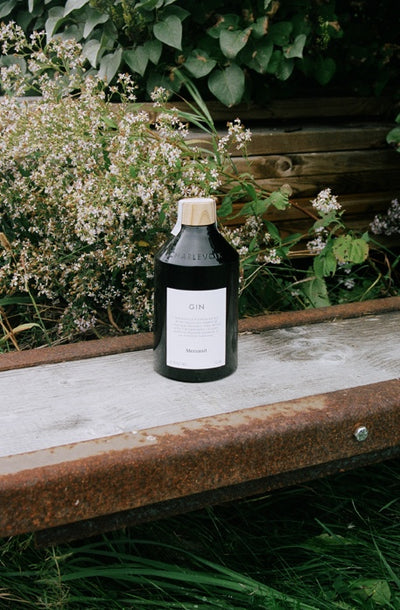Are you old enough to drink alcohol?




Artemisia absinthium, also known as common wormwood, is a species of artemisia in the asteraceae family. It can be found in rocky, high-altitude soils in many European countries. It’s a plant that thrives in the full sun and flowers in the summer season. In Quebec, you’ll find its cousin artemisia vulgaris along paths and in meadows in the wild.
It is renowned for its strong distinct aroma of anise and mint and its bitter taste due to the essential oils and, most specifically, the thujone in the wormwood. In high doses, this organic compound (which is also found in juniper and tansy) can be harmful. Today, thujone is highly regulated in beverages and food.
The history of absinth as an alcoholic beverage dates back to the end of the 17th century when it was touted by a doctor for its tonic, digestive, and antiparasitic properties. It was also believed to relieve fever and stomach aches and, due to its high alcohol content, was even used to purify water for soldiers.
Fast forward a few years. The Pernod distillery’s recipe for absinthe – enjoyed with sugar and ice-cold water – took on the world by storm, propelling the status of a low-cost beverage brimming with enticing flavours. Especially popular with intellectuals, writers, and artists, absinthe began being served in cafés across Europe and abroad where it came to embody the bohemian spirit of the apéro. The green hour had struck.
With an increase in popularity came the critics… and myths. One of the most persistent of the many that abounded was the fear that absinthe could cause hallucinations and even drive people to the brink of insanity. This fear, often inflated, stemmed from the fact that homemade concoctions often contained an unknown quantity of thujone. As a result, absinthe began to be equated with delirium, mental illness, and alcoholism. In reality, the problem boiled down to the fact that drinkers simply overindulged in the spirit.
Absinthe became so popular that it began to compete with wine – a pillar of the French economy. In fact, its popularity, combined with its high alcohol content and relatively affordable price, threatened the viability of the country’s vineyards. Critics doubled down and viticulturists began a public campaign to demonize absinthe, echoing the fears that it could harm a drinker both mentally and physically.
Partly motivated by economic concerns, these criticisms also served to fuel temperance movements and campaigns to restrict or ban the consumption of absinthe. Myriad protests eventually led to absinthe being officially banned in Europe at the beginning of the 20th century.
In the early 2010s, regulations governing thujone dosage were reviewed. As a result, absinthe enthusiasts in Europe and Quebec were able to once again renew ties with the Green Fairy.



Absinthe has earned a reputation for inspiring some of history’s most famous impressionists and poets. Many in the art community credited the green spirit for opening their minds and rousing their imagination. Some artists even chose to depict absinthe in their art, amid scenes of daily life, in cafés, or even in tableaus representing solitude. For many, absinthe symbolized the antithesis of a monotonous, tedious life and a path to introspection steeped in enticing mysticism.
Because of its unique properties and its past, absinthe is known under many names. For instance, it’s been called the Green Fairy due to its emerald colour and its hallucinatory – some would say magical – properties that were said to foster creativity. Absinthe became so popular that happy hour was known as “the green hour” in artistic communities. The beverage was also known as “L’Opale” (the Opal) due to the milky emulsion that resulted from diluting the spirit with water and sugar, a cloudy mixture that evoked the iridescence of the precious stone.


Imbibing in absinthe has often been associated with a theatrical ritual that involves carefully preparing and then enjoying the beverage.
First, a sugar cube is placed on a flat, perforated spoon resting on the rim of a glass containing absinthe. An absinthe fountain is then used to slowly drip ice-cold water into the glass, thereby progressively diluting the mixture while releasing the fragrances and emulsifying the essential oils. This process creates the ouzo effect, also known as the louche, when the drink turns into a cloudy liquid. An experience designed to enthrall the senses.
This method of enjoying absinthe is still used today and our cocktail section features myriad recipes associated with this ritual.

Crafting this mythical beverage begins with the use of the “grande” and “petite” absinthe. The former is used for its bitter, floral character while the latter adds a touch of sweetness to the recipe. Annise and fennel are then added to neutral wheat and rye alcohol to start the first maceration. The mixture is then heated and the vapours collected in liquid form. This step produces a clear absinthe.
During the second maceration, plants harvested from Ferme Ciel sur Mer in La Malbaie are added to the process. The botanicals are inserted in large infusion bags placed in the liquid, then carefully pressed in order to extract as much chlorophyll as possible. The liquid produced is naturally green.
The final step of the process consists in diluting the absinthe to 71% and letting it rest in the tank for a week.
Available in small 350 mL bottles for an iridescent tasting experience.